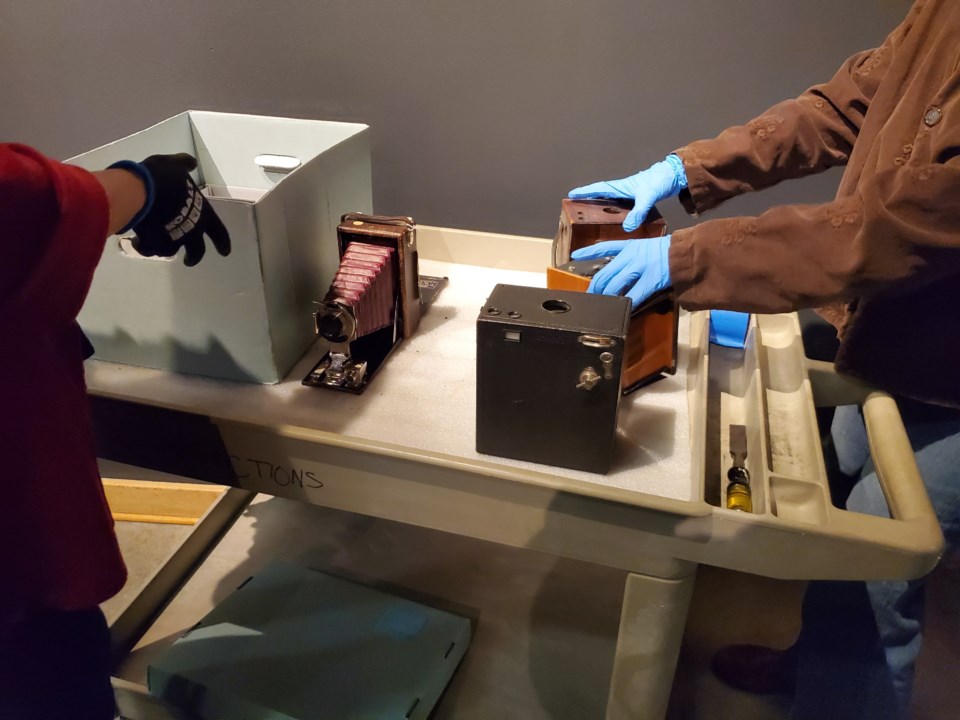The museum is operating between a rock and a wet place — caught between the hard reality of courtyard construction and the unexpected hiccup of a busted pipe — diligently working to bring a new exhibit, “Picturing the West,” to life by Friday night.
The recent weeks have witnessed the dismantling of the “agriCULTURE: Art Inspired by the Land” display, with corn stalks carefully returned to their original field to decompose naturally. As the strands are swept up, the museum staff is immersed in a flurry of activity — printing, unpacking and breathing life into the unfolding narrative of the West.
Within this thoughtfully assembled assortment, mammoth-plate photographs captured by renowned figures such as Carleton Watkins, William Henry Jackson and Eadweard Muybridge take center stage. Centered among these well-known names are seldom-seen works from female photographers and photographers of color from the same era.
Numerous photographers embarked on geological surveys, documenting the West in the process. Some of them were pioneers in this endeavor, capturing the essence of Yosemite before it gained national park status, circulating these photos among Congress and garnering appreciation for the captivating beauty they had documented.
Jared Thompson, curator of exhibits at the Longmont Museum, illuminated the formidable challenges faced by photographers during that era, emphasizing the physical demands of hauling large cameras and plates into the wilderness.
“They also had to deal with tripods, bottles of chemicals and glass plates,” Thompson said. “They would take a glass plate, put this sticky substance on it and then dip it in this silver nitrate solution, making it light-sensitive. This had to be done in a dark room, and they brought a dark tent with them that didn’t allow any light.”
This hands-on nature underscored the meticulous dedication and expertise required to capture the untamed beauty of the American West in the early days of photography. The evolution from painstaking wet plate techniques to the convenience of contemporary pocket-sized space-aged technology highlights the transformative journey of photography and its accessibility to today’s audience.
The Longmont Museum has delved into photography like this before, a few years ago hosting an Ansel Adams show that was a success. Similar to the Ansel Adams showcase, museumgoers seem to have a keen interest in the actual cameras used from the era. Incorporating the visual appeal of these devices was well-received previously and is something they wanted to include in this exhibit.
While many might associate Westward photography with Ansel Adams, it’s essential to note that this collection predates his iconic work. Carleton Watkins, a true pioneer in the field, was capturing the essence of the West long before Ansel Adams picked up a camera.
Additionally, a side gallery will feature Longmont through the lens of Geneva Gettmann. During the 1950s and 1960s, Gettmann captured rural scenes in Longmont, providing a glimpse into our community’s history. The collection, generously donated by her brother a few years ago, adds a touch of hometown reminiscence to the museum’s exhibit, offering visitors a chance to connect with Longmont’s past through the artistry of a local photographer.
“Picturing the West” kicks off its grand reveal on the evening of Friday from 6 to 8 p.m. and gallops through the plains of artistic delight until May 5. Wrangling your way into this spectacle will cost $8 for adults, or $5 if you’re a student, senior or veteran. Little cowpokes age 3 and under, along with trusty Longmont Museum members, can mosey on in for free.
The museum encourages folks to don their fanciest picture-ready attire for a Kodak moment. Appetizers will be rustled up and a cash bar will be on hand for those in need of a little liquid courage. Lasso tickets and let the photographic hoedown begin.



